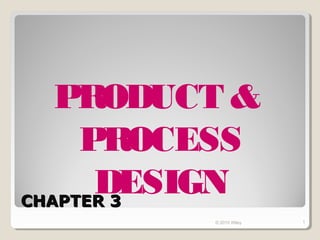
Ch03 (1)
- 1. PRODUCT & PROCESS DESIGN CHAPTER 3 © 2010 Wiley 1
- 2. SAMSUNG S3 © 2010 Wiley 2
- 3. SAMSUNG GALAXY NOTE © 2010 Wiley 3
- 4. IPHONE 4 © 2010 Wiley 4
- 5. IPHONE 5 © 2010 Wiley 5
- 6. © 2010 Wiley 6
- 7. Can we do it? How will we do it? How much longer will it take? How much will it cost? © 2010 Wiley 7
- 8. Product Design & Process Selection Product design – the process of defining all of the companies product characteristics ◦ Product design defines a product’s characteristics of: •appearance, •tolerances, and •materials, •performance •dimensions, standards. Process Selection – the development of the process necessary to produce the designed product. © 2010 Wiley 8
- 9. DESIGN OF SERVICES versus GOODS Servicedesign is unique; it defines the characteristics of a service • Physical elements ,aesthetic & psychological benefits e.g. Promptness, friendliness and ambiance Product and service design must match the needs and preference of the targeted customer group © 2010 Wiley 9
- 10. The Product Design Process Idea development: all products begin with an idea whether from: ◦ customers, ◦ competitors or ◦ suppliers Reverse engineering: buying a competitor’s product © 2010 Wiley 10
- 11. Ideadevelopments selection affects ◦ Product quality ◦ Product cost ◦ Customer satisfaction Overall manufacturability – the ease with which the product can be made IDEA DEVELOPMENT © 2010 Wiley 11
- 12. Havaianas vs Havana © 2010 Wiley 12
- 13. Louis Vuitton © 2010 Wiley 13
- 14. Product Design Process © 2010 Wiley 14
- 15. The Product Design Process Step 1 - Idea Development Step 2 - Product Screening Step 3 – Preliminary Design and Testing Step 4 – Final Design © 2010 Wiley 15
- 16. The Product Design Process Step 1 - Idea Development - Someone thinks of a need and a product/service design to satisfy it: customers, marketing, engineering, competitors, benchmarking, reverse engineering Step 2 - Product Screening - Every business needs a formal/structured evaluation process: fit with facility and labor skills, size of market, contribution margin, break-even analysis, return on sales © 2010 Wiley 16
- 17. 17
- 18. © 2010 Wiley 18
- 19. The Product Design Process Step 3 – Preliminary design and Testing – Technical specifications are developed, prototypes built, testing Step 4 – Final Design – Final design based on test results, facility, equipment, material & labor skills defined, suppliers identified © 2010 Wiley 19
- 20. © 2010 Wiley 20
- 21. © 2010 Wiley 21
- 22. To further understand watch this video © 2010 Wiley 22
- 23. Product Screening Tool- Break- Even Analysis Computes the quantity of goods company needs to sell to cover its costs Q= Break-Even Quantity Q= F/(SP-VC) F=Fixed Costs SP= Selling Price/Unit VC=Variable Cost © 2010 Wiley 23
- 24. Product Screening Tool – Break- Even Analysis con’t Break-even analysis considers two functions of Q ◦ Total cost – sum of fixed and variable cost Total cost = F + (VC)*Q ◦ Revenue – amount of money brought in from sales Revenue = (SP) * Q Q = number of units sold © 2010 Wiley 24
- 25. Break-Even Analysis: Graphical Approach Compute quantity of goods that must be sold to break- even Compute total revenue at an assumed selling price Compute fixed cost and variable cost for several quantities Plot the total revenue line and the total cost line Intersection is break-even Sensitivity analysis can be done to examine changes in all of the assumptions made © 2010 Wiley 25
- 26. A company is planning to establish a chain of movie theaters. It estimates that each new theater will cost approximately $1 Million. The theaters will hold 500 people and will have 4 showings each day with average ticket prices at $8. They estimate that concession sales will average $2 per patron. The variable costs in labor and material are estimated to be $6 per patron. They will be open 300 days each year. What must average occupancy be to break-even? Break-Even Example: © 2010 Wiley 26
- 27. Break-Even Point Total revenues = Total costs @ break-even point Q Selling price*Q = Fixed cost + variable cost*Q ($8+$2)Q= $1,000,000 + $6*Q Q = 250,000 patrons (42% occupancy) What is the gross profit if they sell 300,000 tickets Profit = Total Revenue – Total Costs P = $10*300,000 – (1,000,000 + $6*300,000) P = $200,000 If concessions only average $.50/patron, what is break-even Q now? (sensitivity analysis) ($8.50)Q = 1,000,000 - $6*Q Q = 400,000 patrons (67% occupancy) Break-Even Example Calculations © 2010 Wiley 27
- 28. Design for Manufacturing (DFM) Guidelines to produce a product easily and profitably ◦ Simplification - Minimize parts ◦ Standardization Design parts for multiply applications ◦ Use modular design ◦ Simplify operations © 2010 Wiley 28
- 29. Product Life Cycle also affects decisions Productlife cycle – series of changing product demand Consider product life cycle stages ◦ Introduction ◦ Growth ◦ Maturity ◦ Decline Facility& process investment depends on life cycle © 2010 Wiley 29
- 30. © 2010 Wiley 30
- 31. © 2010 Wiley 31
- 32. Concurrent Engineering Old “over-the-wall” sequential products design process Each function did its work and passed it to the next function Improved Concurrent Engineering process All functions form a design team that develops specifications, involves customers early, solves potential problems, reduces costs, & shortens time to market © 2010 Wiley 32
- 33. Remanufacturing Use components of old product in the production of new ones Good for: Computers, televisions and automobiles © 2010 Wiley 33